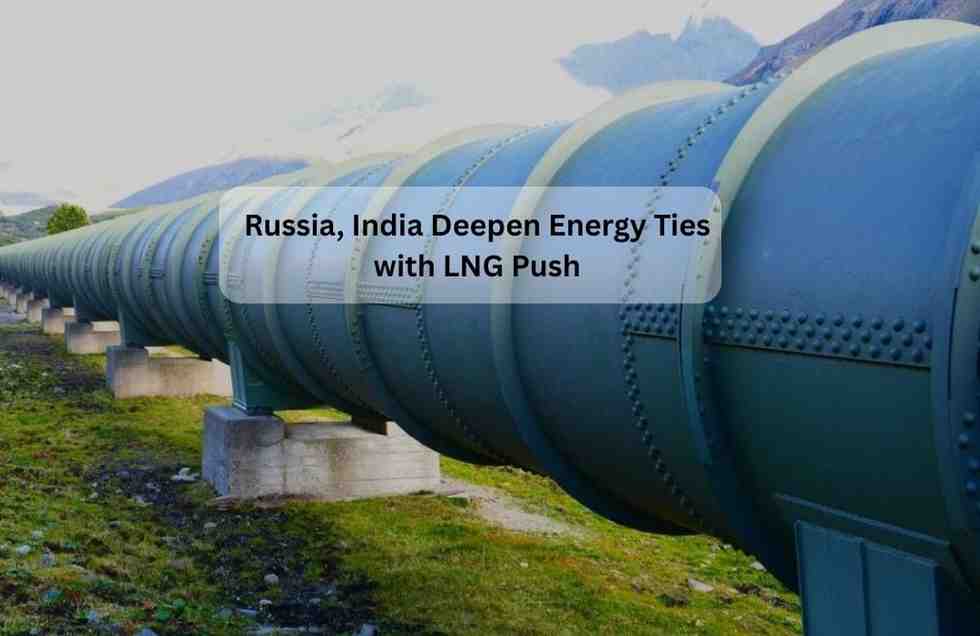Russia Eyes Stronger Energy Partnership with India — Offers to Expand LNG Supplies Amid Rising Demand

In yet another sign of strengthening ties between New Delhi and Moscow, Russia has expressed a clear intent to expand its liquefied natural gas (LNG) supplies to India. This latest move underscores how both nations are aligning their long-term energy goals at a time when the global energy order is rapidly changing.
As India continues to push for cleaner and more sustainable fuel options, natural gas has emerged as a critical part of its transition plan. And for Russia — one of the world’s largest energy exporters — India presents an enormous opportunity to diversify its energy exports beyond traditional European markets.
Russia’s Renewed Energy Pitch to India
Russian Energy Minister Sergey Tsivilyov, in a recent conversation with state-run news agency TASS, confirmed Moscow’s readiness to step up LNG exports to India through both existing and upcoming projects.
“Given India’s plans to increase the share of gas in its energy mix to 15%, we are ready to offer LNG from both current and future Russian projects,” Tsivilyov said.
His remarks signal a broader strategic alignment: India is moving aggressively toward cleaner fuel alternatives, while Russia is looking eastward for new markets in Asia after facing constraints in Europe.
Currently, natural gas accounts for roughly 6–7% of India’s total energy mix. The government aims to more than double this figure to 15% by 2030, and collaborations like this could be key in achieving that goal.
Strengthening a Time-Tested Partnership
Energy has always been one of the strongest pillars of the India–Russia partnership, spanning decades of cooperation in oil, coal, and nuclear energy. Over the years, this relationship has only deepened, even as global political equations have shifted.
Earlier, Russian First Deputy Prime Minister Denis Manturov had described India as one of Russia’s most trusted partners, noting that Moscow continues to be a reliable supplier of crude oil, coal, and petroleum products to the Indian market. He also emphasized “huge potential” in expanding LNG trade and joint infrastructure ventures.
This recent announcement by Tsivilyov appears to build directly on that foundation — transforming what was once a limited energy partnership into a more diversified and future-oriented alliance.
The Road So Far: Expanding Gas Cooperation
The growing synergy between the two countries didn’t start overnight. Back in July 2024, Russian Deputy Prime Minister Alexander Novak revealed that India and Russia were already in active discussions to enhance gas-sector collaboration.
At that time, Russia was supplying close to 3 million tons of LNG per year to India — a figure that experts believe could grow substantially in the coming years. The two sides have reportedly explored not only higher volumes of LNG trade but also potential joint investments in LNG terminals, storage facilities, and cross-border pipeline infrastructure.
Such cooperation would not only secure India’s long-term energy needs but also give Russian energy companies a stronger foothold in one of the world’s fastest-growing fuel markets.
Why This Development Matters
For India, the timing couldn’t be more critical. The country’s energy demand is expected to double by 2040, driven by rapid industrialization, urban expansion, and rising household consumption. To meet this demand sustainably, India needs to cut down its dependence on coal — which currently dominates its power generation — and shift toward cleaner alternatives like natural gas.
LNG is often called a “bridge fuel,” as it produces significantly lower carbon emissions compared to coal and oil. It also allows India to balance its ambitious renewable energy goals with the need for consistent power supply.
For Russia, meanwhile, this deal represents more than just a trade opportunity. Following Western sanctions and reduced energy exports to Europe, Moscow has been steadily pivoting toward Asian energy markets, with India and China emerging as key destinations.
This diversification not only strengthens Russia’s position as a global LNG powerhouse but also ensures economic resilience amid shifting geopolitical landscapes.
The Road Ahead: Toward a Long-Term Energy Alliance
If ongoing talks lead to concrete agreements, India could soon import a much larger share of its LNG from Russia — potentially reshaping the balance of its gas imports. Analysts believe that expanding this partnership could accelerate India’s clean energy transition, while also locking in long-term supply stability and price advantages.
Beyond trade, both sides are expected to explore joint ventures in technology, infrastructure, and logistics — areas that could make the LNG value chain more efficient. There are also discussions about collaboration in new-generation energy technologies, including hydrogen and carbon capture solutions.
Given the pace of diplomatic and economic engagement between the two nations, experts suggest that new memorandums of understanding (MoUs) or commercial deals could emerge in the coming months.
The Bigger Picture: A Win-Win for Both Nations
This evolving partnership is a reflection of mutual strategic interests. India gains access to stable, affordable energy supplies essential for its growing economy, while Russia finds a dependable market for its expanding LNG output.
In many ways, this relationship goes beyond trade — it’s about energy security, strategic autonomy, and sustainable growth. As both countries work toward diversifying their economic ties, the energy sector stands out as a key area of collaboration for decades to come.
Key Takeaways
- Russia has offered to expand LNG supplies to India from both existing and upcoming projects.
- India’s goal is to increase the share of natural gas in its energy mix from 6–7% to 15% by 2030.
- Current LNG imports from Russia stand at around 3 million tons per year, with significant growth potential.
- Both countries are exploring joint projects in LNG infrastructure, pipelines, and storage facilities.
- The move aligns with India’s clean energy transition and Russia’s pivot to Asian markets.
As the global energy map evolves, the deepening partnership between India and Russia signals a new era of cooperation that could shape the future of Asia’s energy landscape. With both nations seeking stability, affordability, and sustainability, this LNG expansion could mark a turning point — one that binds two long-standing allies through the power of shared energy goals.



